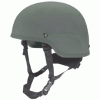M1 steel helmet
Случайные:

Фуражка офицерская парадная Вооруженных Сил Латвии

Нарукавный знак 2060-й базы хранения и ремонта ВВС Республики Беларусь

Нарукавный знак персонала портов загрузки
Редактировать или перевести информацию
Другие версии
Note: This entry will cover the M1 steel helmet and will mainly focus on its role in modern conflicts
overview:
Weight: 2.85 lbs. (1.29 Kg.)
Ballistic coverage: back top, and sides of upper cranium
NIJ level: aprox. IIa (stopped .45acp (11.4x23mm) U.S. mil. ball ammunition in tests)
Designed: 1940
Used: issued 1945
Accessory(s): liner, paratroop liner, helmet net, and varios covers
Technical Description:
The M1 steel or ¨pot¨ helmet is a metal helmet stamped out of non-magnetic manganese steel and is 3mm thick. The helmet from the factory only has a chin strap and is bare on the inside, a liner or suspension system may be attached to help negate a portion of blunt force trauma normally received through the helmet. The helmet's shell is painted Army green number 3 which is also known as army green or olive drab, Later users of the M1 helmet used cloth helmet covers which reduced the reflectivity of the helmet and allowed it to be used in the snow without horribly outlining the user. These covers were mainly produced in olive drab and snow white for use in winter.
History
The M1 helmet was the product of the sub-par protection afforded by the previous M1917 helmet. The helmets first saw conflict in the second world war and were adequate for the duration of the war and over 22 million were produced by 1945. Soldiers issued the helmet often wore it with the chinstrap unbuckled to prevent an attacker from grabbing the helmet in order to but the soldier off balance another reason for this was the mistaken belief was that if the chinstrap were worn the pressure wave or shockwave from a shell would snap the user's neck however neck injuries due to use of the chinstrap where exhibited in a failed D-day exercise where a troop transport ship was critically damaged and as it sank the soldiers onboard jumped off and ones wearing the strap suffer major and mostly fatal neck and spinal injuries caused by the brim of the helmet hitting the water. however, this phenomenon appears to be an isolated incident. The M1 helmet served in every US conflict up to the late 1980s when it and the M-69 flak vest was phased out and replaced with the PASGT system. The M1 helmet and its derivatives are found all across the globe due to the US´s lend-lease program.
overview:
Weight: 2.85 lbs. (1.29 Kg.)
Ballistic coverage: back top, and sides of upper cranium
NIJ level: aprox. IIa (stopped .45acp (11.4x23mm) U.S. mil. ball ammunition in tests)
Designed: 1940
Used: issued 1945
Accessory(s): liner, paratroop liner, helmet net, and varios covers
Technical Description:
The M1 steel or ¨pot¨ helmet is a metal helmet stamped out of non-magnetic manganese steel and is 3mm thick. The helmet from the factory only has a chin strap and is bare on the inside, a liner or suspension system may be attached to help negate a portion of blunt force trauma normally received through the helmet. The helmet's shell is painted Army green number 3 which is also known as army green or olive drab, Later users of the M1 helmet used cloth helmet covers which reduced the reflectivity of the helmet and allowed it to be used in the snow without horribly outlining the user. These covers were mainly produced in olive drab and snow white for use in winter.
History
The M1 helmet was the product of the sub-par protection afforded by the previous M1917 helmet. The helmets first saw conflict in the second world war and were adequate for the duration of the war and over 22 million were produced by 1945. Soldiers issued the helmet often wore it with the chinstrap unbuckled to prevent an attacker from grabbing the helmet in order to but the soldier off balance another reason for this was the mistaken belief was that if the chinstrap were worn the pressure wave or shockwave from a shell would snap the user's neck however neck injuries due to use of the chinstrap where exhibited in a failed D-day exercise where a troop transport ship was critically damaged and as it sank the soldiers onboard jumped off and ones wearing the strap suffer major and mostly fatal neck and spinal injuries caused by the brim of the helmet hitting the water. however, this phenomenon appears to be an isolated incident. The M1 helmet served in every US conflict up to the late 1980s when it and the M-69 flak vest was phased out and replaced with the PASGT system. The M1 helmet and its derivatives are found all across the globe due to the US´s lend-lease program.
Еще из категории: Шлемы, Каски
 PASGT systems helmet (Pre 2000)
PASGT systems helmet (Pre 2000)
 Облегченный шлем LWH морской пехоты США
Облегченный шлем LWH морской пехоты США
 Полезащитный шлем MICH TC 3000. Уровень защиты IIIA армии США
Полезащитный шлем MICH TC 3000. Уровень защиты IIIA армии США
 Кевларовый укороченный шлем ARCH High-Cut Вооруженных Сил США
Кевларовый укороченный шлем ARCH High-Cut Вооруженных Сил США
 Шлем для экипажей боевой техники DH-132® AS Вооруженных Сил США
Шлем для экипажей боевой техники DH-132® AS Вооруженных Сил США


